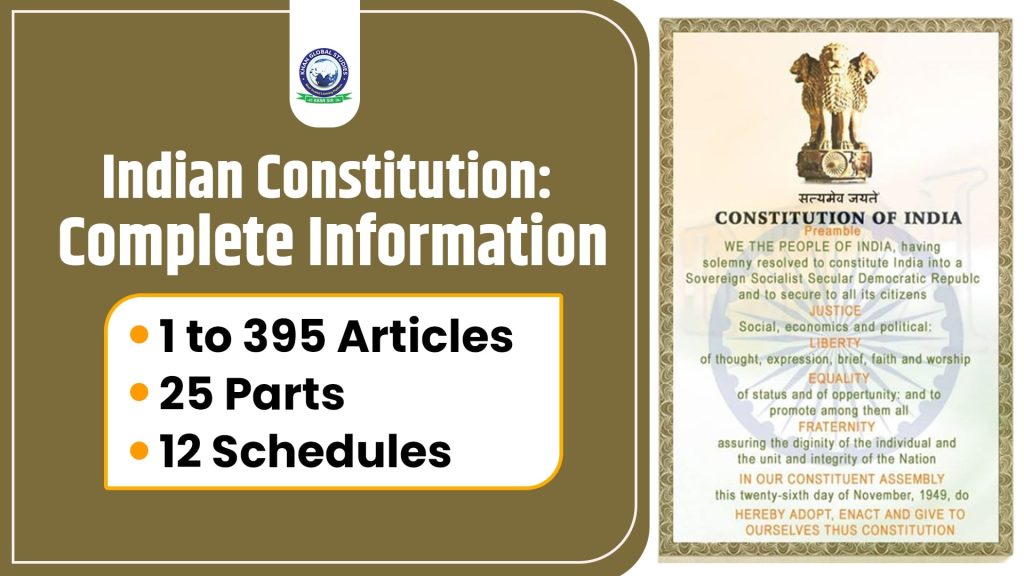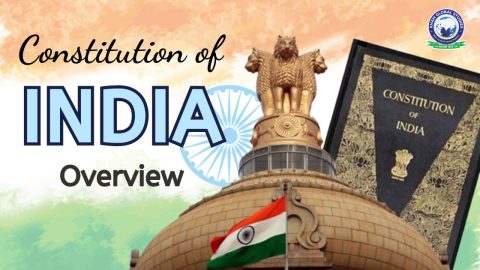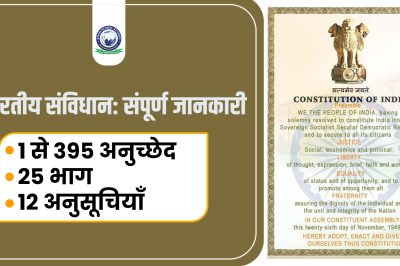
The Indian Constitution is a monumental document, and at its core, it serves as the supreme law of the country. It is a carefully drafted blueprint that outlines the structure, powers and functions of the government as well as the fundamental rights and duties of its citizens. But how extensive is this document and how many articles does it contain?
The Indian Constitution was adopted on 26 January 1950 and consists of a Preamble and 395 articles, divided into 22 parts. These articles cover a wide range of subjects from the fundamental rights of the citizens to the Directive Principles of State Policy, the powers and responsibilities of the President and the Prime Minister and the procedures for amending the Constitution.
List of Parts and Articles of the Indian Constitution
Part I: The Union and its Territory
Part I of the Indian Constitution, consisting of Articles 1 to 4, deals with the name and territory of the Union.
Part II: Citizenship
Part II, consisting of Articles 5 to 11, addresses aspects related to citizenship.
Part III: Fundamental Rights
One of the most important sections of the Constitution is Part III, which consists of Articles 12 to 35. This part outlines the fundamental rights of Indian citizens, such as the right to equality, the right to freedom, the right against exploitation, right to religious freedom. , and cultural and educational rights.
Part IV: Directive Principles of State Policy
Articles 36 to 51 in Part IV discuss the Directive Principles of State Policy, which guide the government in making laws and policies for the welfare of the people.
Part V: Union
Part V of the Indian Constitution, including Articles 52 to 151, deals with the executive powers and duties of the President, Vice President, Prime Minister and Council of Ministers.
Part VI: State
Part VI, consisting of Articles 152 to 237, details the powers and functions of state governments.
Part VII: States in Part B of the First Schedule
Part VII deals with the States in Part B of the First Schedule to the Constitution.
Part VIII: Union Territories
Articles 239 to 242 in Part VIII are devoted to Union Territories.
Part IX: Panchayats
Part IX, with Articles 243 to 243O, addresses the composition and organization of Panchayats.
Part IX A: Municipalities
Part IXA, consisting of Articles 243P to 243ZG, discusses municipalities.
Part IX B: Co-operative Societies
This section includes Article 243ZH and deals with cooperative societies.
Part X: Scheduled and Tribal Areas
Part X, Which includes Articles 244 and 244A, discusses the administration of Scheduled and Tribal Areas.
Part XI: Relations between the Union and the States
Part XI, consisting of Articles 245 to 263, outlines the distribution of legislative powers between the Union and the States.
Part XII: Finance, Property, Contracts and Lawsuits
Part XII deals with financial matters and contains Articles 264 to 300A.
Part XIII: Trade, commerce and intercourse within the territory of India
Articles 301 to 307 in Part XIII discuss trade, commerce and intercourse within the territory of India.
Part XIV: Services under the Union and the States
Part XIV, including Articles 308 to 323, deals with services under the Union and the States.
Part XIV A: Tribunal
Part XIVA deals with tribunals and contains Articles 323A and 323B.
Part XV: Elections
Part XV, consisting of Articles 324 to 329, discusses elections.
Part XVI: Special provisions relating to certain classes
Part XVI contains Articles 330 to 342, which address special provisions for Scheduled Castes, Scheduled Tribes and Anglo-Indian representation in Legislative Assemblies.
Part XVII: Official Language
Part XVII discusses the official languages of India and consists of Articles 343 to 351.
Part XVIII: Emergency Provisions
This section includes Articles 352 to 360 as well as emergency provisions.
Part XIX: Miscellaneous
Part XIX contains Articles 361 to 367, which are miscellaneous provisions.
Part XX: Amendment of the Constitution
Part XX discusses the procedures for amending the Constitution and contains Articles 368 to 378.
Part XXI: Temporary, transitional and special provisions
Part XX contains articles 379 to 392, which deal with temporary, transitional and special provisions.
Part XXII: Short title, commencement, official text in Hindi and repeal
The final part, Part XXII, contains Articles 393 and 394, which specify the short title, commencement, official text and repeal of certain laws in Hindi.
Schedules of the Indian Constitution
There are a total of 12 schedules in the Indian Constitution, which are as follows:
1st schedule
The various states and union territories of India are mentioned in the First Schedule of the Indian Constitution. For example, there are currently 28 states and 8 union territories mentioned in the First Schedule of India. Mention of any new State or creation of any Union Territory requires amendment of the First Schedule. Delhi was declared the National Capital Territory by the 69th Amendment of the Constitution.
2nd schedule
The Second Schedule of the Indian Constitution mentions the salaries, allowances and pensions of officers like the President, Governor, Lok Sabha Speaker-Deputy Speaker, Rajya Sabha Speaker-Deputy Speaker, Legislative Assembly Speaker, and High Court. And there are Supreme Court judges, CAG etc. In brief, the salaries, allowances and pensions of various officers are mentioned in the Second Schedule.
3rd schedule
The Third Schedule of the Constitution provides for the taking of oaths by various officers like ministers, High Court and Supreme Court judges, etc. Briefly, the Third Schedule deals with oaths.
4th schedule
Rajya Sabha seats are allocated from different states in the Fourth Schedule of the Indian Constitution. This is very important, in which it is decided how many seats will come in Rajya Sabha from which state.
5th schedule
The Fifth Schedule provides for the administration and control of various Scheduled and Scheduled Tribe areas. These areas are spread over several states of India, information related to their administration is given in the Fifth Schedule.
6th schedule
The Sixth Schedule of the Constitution makes provisions regarding the administration of the tribes of the States of Assam, Meghalaya, Tripura and Mizoram. This schedule is also important, to remember you can remember it with the words Assam, Tripura, Meghalaya, Mizoram (ATMM).
7th schedule
The Seventh Schedule of the Constitution gives information about the distribution of various powers between the Center and the States. It is very important. Provision for three lists has been made in the Seventh Schedule itself, which are as follows –
- Union List,
- State List,
- Concurrent List.
8th schedule
The most important schedule of the Constitution is the Eighth Schedule and questions are asked from here in your examination also.
- Languages are mentioned in the Eighth Schedule of the Constitution.
- At present a total of 22 languages are included in the Eighth Schedule.
- When the Constitution came into force the Eighth Schedule originally included 14 languages, but currently it includes 22 languages.
9th Schedule
The Ninth Schedule of the Constitution was added to the Constitution by the First Constitutional Amendment in 1951. Acquisition of property is mentioned under this schedule. The special thing is that the subjects included in the Ninth Schedule cannot be challenged in court. At present about 284 Acts are included in this schedule.
10th schedule
The Tenth Schedule of the Constitution was added by the 52nd Constitutional Amendment in 1985, which contains provisions related to defection.
11th schedule
The Eleventh Schedule of the Constitution was added by the 73rd Constitutional Amendment, 1992 (came into force in 1993). Panchayati Raj is mentioned in the Eleventh Schedule. At present, the Eleventh Schedule contains 29 subjects related to Panchayati Raj.
12th schedule
The 12th Schedule of the Constitution was added by the 74th Constitutional Amendment in 1993. Local government i.e. municipalities in urban areas has been mentioned in the 12th Schedule of the Constitution. At present, the Twelfth Schedule for Municipalities contains 18 subjects.
Why is the Constitution of India called a “Bag of Borrowed”?
The Constitution has many borrowed features. The founders of the country were so intelligent that they borrowed good features from different countries and created a constitution that was best suited for India. The effects of other constitutions are listed below.
| Constitution | Borrowed Features |
| British | Parliamentary system Constitutional Head of State The Lower House of Parliament more powerful than the Upper House Responsibility of the Council of Ministers towards Parliament Prevalence of the rule of law |
| US | Preamble Fundamental Rights Functions of Vice-president Amendment of Constitution Nature and functions of the Supreme Court Independence of the judiciary |
| Australian | List of concurrent powers Procedure for solving deadlock over concurrent subjects between the Centre and the States |
| Irish | Directive Principles of State Policy Method of nomination of members to the Rajya Sabha |
| Weimer Constitution of Germany | Powers of the President |
| Canadian | Provisions of a Strong Nation Name of the Union of India Vesting residuary powers |
| South African | The procedure of amendment with a two-thirds majority in Parliament (To read about the types of amendments, follow the linked article.) Election of the members of the Rajya Sabha on the basis of proportional representation by the State Legislatures |
Conclusion
The Indian Constitution, with its 395 articles, is a testament to the country’s commitment to democracy, justice and equality. Its comprehensive nature ensures that all aspects of governance and fundamental rights are well-defined. It remains a living document, reflecting the evolving needs and aspirations of a dynamic and diverse nation.
FAQs
Q1. How many Articles are there in the Indian Constitution?
A: The Indian Constitution initially had 395 articles in 22 parts. After several amendments over the years, the current version of the Constitution of India consists of 448 articles. The 448 articles have been divided into 25 parts.
Q2. Who is the “Father of Indian Constitution”?
A: Dr. Bhimrao Ambedkar is also known as the father of the Indian Constitution. On August 29, 1947, the Constituent Assembly constituted a drafting committee. Ambedkar was the chairman of this draft committee.
Q3. When do we celebrate Constitution Day (Samvidhan Divas)?
A: Constitution Day, also known as ‘Samvidhan Divas’, is celebrated in our country every year on 26 November to commemorate the adoption of the Constitution of India. On 26 November 1949, the Constituent Assembly of India adopted the Indian Constitution, which came into force on 26 January 1950.
Q4. Who wrote the first Indian Constitution?
A: Prem Bihari Narain Raizada was the calligrapher of the first Indian Constitution. The original constitution was handwritten by him in flowing italic style.
Q5. How many amendments have been made to the Indian Constitution so far?
A: As of September 2023, the Constitution of India has undergone 106 amendments since it was first enacted in 1950.





